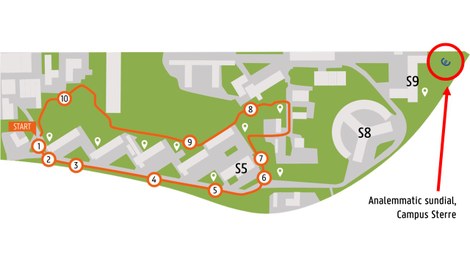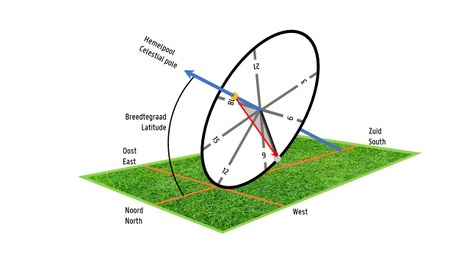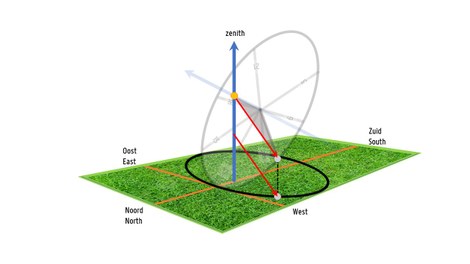Sundial on Campus Sterre

The analemmatic sundial on Campus Sterre is located on the most southern and sunny place on campus: in the lawn next to building S9. The sundial is easily accessible by following the jogging track along S8 and behind S9, parallel to the Krijgslaan. To find out how this sundial works, we first look at the apparent movement of the Sun in the sky and how it can be made visible.
The equatorial sundial
The Sun makes a daily circle around the celestial pole as a result of the Earth's rotation around its axis. This daily movement can be visualised by pointing a style, e.g. a metal rod, to the celestial pole and catching its shadow on a circular disk perpendicular to the rod. That disc is then parallel to the Earth’s equatorial plane. The style's shadow rotates through a full circuit once every solar day (the Sun is of course below the horizon for part of the day). This is the principle of an equatorial sundial (see picture).
The Sun is south of the equatorial plane from September to March and north of the equatorial plane from March to September. As a result, the Sun shines on the top of the disk during summer and on its bottom during winter. Therefore, the point on the style that casts its shadow right on the edge of the circular disk, called the "active point", moves up and down along the style throughout the year. Each day has its own active point on the style. That active point is shown on the image as a golden sphere. The grey sphere on the edge of the hour disc is the shadow of the active point. The red arrow shows the shadow line from the active point to that shadow point.
The analemmatic sundial
If we project an equatorial sundial perpendicularly downwards on a horizontal plane, for example on the ground, we obtain an analemmatic sundial. Because the circular disk of an equatorial sundial is tilted in the north-south direction, its perpendicular projection on the ground is a north-south flattened ellipse. The black ellipse on the ground in the accompanying drawing is the perpendicular projection of the hour disc of the original equatorial sundial (shown here in transparent) on the ground.
We now place an upright pole on the table, such that it passes through the active point. The position along the north-south direction of the vertical style therefore depends on the date. We project the original shadow point perpendicularly downwards, yielding the grey sphere on the ellipse on the ground. The original grey sphere is the shadow of the active point on the original style. The grey sphere projected on the ground is clearly the shadow of a point on the new, vertical style. In other words, the grey sphere on the analemmatic sundial on the ground displays the hour just as well as the original grey sphere on the equatorial sundial. Consequently, the hour points of an analemmatic sundial lie on an ellipse flattened along the north-south direction. If we place such an ellipse with a long axis of 5 metres along the east-west direction at the latitude of Ghent, it has a short axis of 3.9 metres in the north-south direction.
The price we pay for the convenience of a vertical style is that its position is date-dependent and shifts back and forth along the north-south line throughout the year. Of course, the vertical style of an analemmatic sundial does not have to be a metal rod. You can take the place of the style and be an active part of this sundial! So stand at the appropriate place on the centre line of the Campus Sterre sundial (the first day of each month is marked so you can estimate where you should stand) and your shadow will indicate the time. This sundial shows winter time. Add one hour to the time when summer time is in effect.
Longitude
Ghent lies 3.7 degrees east of the prime meridian, which puts our solar time a quarter of an hour ahead of Greenwich time. At local noon, when the Sun is at its highest point as seen from Ghent, and sits exactly above the north-south line, local solar time is by definition 12:00. In Greenwich, local solar time is then about 11:45. The time zone in which Ghent is located is 1 hour ahead of Greenwich's solar time, placing local noon at around 12:45 here. Hence the north-south line on the central stone of the sundial points towards a quarter to one in the afternoon.
The equation of time
The daily apparent motion of the Sun in the sky is a combination of two motions: the rotation of the Earth around its axis, on the one hand, and the orbital motion of the Earth around the Sun, on the other. It is mainly the latter that makes it difficult to use the Sun as a clock, for two reasons:
- The Earth follows an elliptical orbit around the Sun and moves faster when it is closer to the Sun (early January) and slower when it is further from it (early July).
- The Earth's orbital plane is tilted with respect to the equatorial plane. The projection of the Earth's orbital velocity on the equatorial plane is therefore variable: it is greatest in late December and late June and smallest in late March and late September.
Due to this variability of the Earth's orbital motion, projected on the equatorial plane, the speed of the Sun's daily apparent motion in the sky varies and consequently so does the length of a solar day. As a result, the Sun is sometimes ahead, sometimes behind our clocks that tick away neatly 24 hours each day. The difference between the time indicated by the Sun on a sundial and the time indicated by a clock is called the equation of time. This figure shows the equation of time, as clock time minus solar time, as a function of date (the first day of each month is indicated). The equation of time is also shown on the centre stone of the sundial on Campus Sterre. Using the date lines and the time scale on the dial’s central stone, you can estimate how many minutes to add to the time read from the sundial. In February, for example, you need to add about 15 minutes. In May, you need to subtract five minutes while in August you need to add five minutes. In November, you have to subtract more than a quarter of an hour to convert the measured solar time into clock time.
The analemmatic sundial on Campus Sterre was made possible by the support of UGent's Faculty of Sciences and its dean, Prof. Dr Isabel Van Driessche.
Kristoffel Boudens turned the idea into stone (bluestone recovered from the renovation of the University’s Book Tower).
Prof Annemieke Verbeken helped identify a suitable location on campus.
Prof. Dr. Alain De Wulf, Lander Bral, and Guy Wauters measured the correct position of the sundial. The dial was installed by Jan De Doncker, Michael Torrekens, Paul De Haen, Wouter Beernaert, and Madi Bojang of the UGent Department of Buildings and Facility Management.
Prof. Dr. Sven De Rijcke
Department of Physics and astronomy



